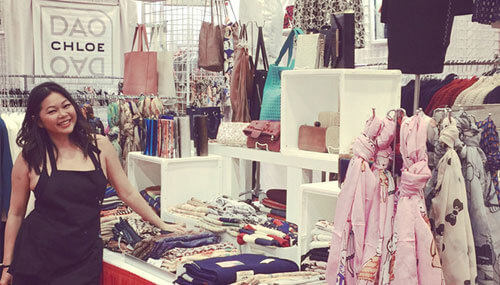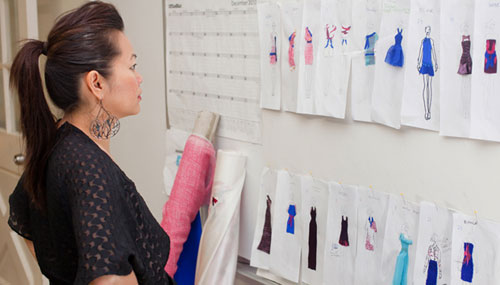Entrepreneur Insight
The Rebranding of “Project Runway” Star Chloe Dao’s Business
By Ellen Chang

How Project Runway star Chloe Dao revamped her brand and reignited sales of her clothing
After the popularity of her clothing line on QVC Inc. diminished, Chloe Dao was forced to make a difficult decision in 2012 – to continue her business as Lot 8, a women’s boutique in Houston, or to rebrand the company into DAO Chloe DAO, a play on her own name. The 43-year old Houstonian knew she had to make a change because the wholesale side of the business was not thriving – she realized that the overhead was too high because the staff was too large.
The fashion designer became famous after her stint on the second season of “Project Runway” in 2006, in the days before reality television was as common as a smartphone. She knew she had to follow the advice of a team of graduate students from Rice University’s business school in Houston to embrace change and rebrand into DAO Chloe DAO.
“I knew I was in trouble and had to cut some of the overhead, or otherwise I would not be able to sustain myself,” she says. “Business owners have to be aware of their bottom line and look at it constantly. I needed a drastic change because fewer people were shopping and clothes became a luxury. I definitely needed to change.”
Even successful, thriving companies need to consider whether rebranding their company should be part of their strategy for growth. Dao took the leap sanguinely and took the advice of the business school students, who spent six months poring over her financial statements and forecasting her revenue for the following year.
“Their advice was brutal, but you have to be ready for it,” she says. “Businesses have ebbs and flows and you have to be able to float with the ups and downs.”
Janet Gurwitch, co-founder of Gurwitch Products LLC advised Dao that the reason why her business, which manufactures Laura Mercier Cosmetics, succeeded was because, “my name had a brand to it and I learned to embrace it.”
How she came to make the change
After her overwhelming popularity on “Project Runway,” Dao returned to Houston and continued designing cocktail and evening dresses, and expanded her line to include more ready-to-wear and every day dresses, along with some sportswear. She loved being on QVC for three years, which required her, as company spokeswoman, to engage more than 90 million U.S. audience members at home with quick-paced, nonstop banter about her products to entice them to call. A natural speaker who does not get flustered and is not daunted by the pressure of watching the live sales figures on a screen a few feet in front of her, Dao enjoyed being on her feet and discussing the attributes of dresses and even sportswear for 10 consecutive minutes without a break.

"My name had a brand to it and I learned to embrace it."
For three years, Dao designed clothing for the masses and made everything locally in Houston, ensuring items were affordable for her clients, who ranged from teenage girls attending their first dance to some of society’s richest and best-dressed women, who were attending galas for charities.
She realized this experience made “me a better designer,” since she had to create a diverse array of attire for women size XS to 3X and ages 16 to 70 years old.
While selling her clothing on QVC was an instant success, it also contributed 25 percent to her profit, which, in retrospect, may have been too big a chunk. When the recession hit in 2008, the impact was felt nearly immediately, Dao says.
When Chloe Dao emerged
By 2012, the overhead at the boutique was outpacing sales because the storefront was nearly two times its current size and it had a large staff. Dao changed the brand because her journey had a unique spin on an old story behind it. Fans of “Project Runway” had fallen in love with the tale of the fashion designer who spent eight years in New York working in nearly every aspect of the fashion industry. Dao was a Girl Friday, working seven days a week, opening and closing a boutique. Later, she had positions as a bookkeeper, cutter, pattern maker, window dresser and designer, and eventually she landed back in Houston in 2000.
“I saw all the details up close, and it was great to work in these environments to see how a small business worked,” Dao says. “I always knew I wanted to have my own business and wanted to follow in my mom’s footsteps [and be] an entrepreneur – if she didn’t speak English and made her own clothes to sell at the flea market, I knew I could do it.”
The changes she made
Being a household name still afforded her a lot of credibility, so Dao followed the advice of the business students and took the challenge. She decreased her staff, eliminated the wholesale business and cut down the square footage of her boutique to make it more cozy, but still roomy enough for the customers to walk around.
The reaction from her customers to the rebranding and new logo was positive – they responded well and sales rose.
“They loved it,” she says. “We still had a lot of open space and the clothes were the same.”
Changing the branding of a company to reflect the founder’s personality can be daunting and is a “big commitment,” Dao admits. “I’m a real person and I didn’t want to be a brand at first because there are certain expectations.”
Dao was concerned about disappointing her fans, some of whom travel to Houston just to shop in her boutique, but she genuinely enjoys interacting with them.
“Thank God, it comes naturally to me,” she says.
Now the focus is returning to the core of the fashion business – analyzing trends, conducting seminars to educate customers, updating her dresses constantly and examining her current demographic to offer choices that customers need. Another challenge was to scrap her previous website and relaunch it this past February so shopping online would be easier.
“The goal was to have great clothes and a more modern take [on] classic clothing you can wear forever,” she says. “I am becoming much smarter with my purchases, so I can give customers something that they don’t see anywhere else.”
How companies need to rebrand themselves
When companies engage in rebranding, a fundamental concern should be the impact on the brand, says Jacquelyn Thomas, an associate professor of marketing at Southern Methodist University’s Cox School of Business in Dallas.
“Firms should seek to manage ‘customer-based brand equity,’ which is driven by the differential effect that brand knowledge has on the customer's response to the marketing of the brand,” she says. “It can be an important source of a company's competitive advantage.”
Companies must have a good grasp of the needs of their current and prospective customers and “take this into account when repositioning and rebranding the product or the company,” Thomas says.
A successful rebranding can help a company increase its product offerings, which are closely related to that revised identity and can result in “opportunities for higher share and firm growth,” she adds.
“Rebranding can open up opportunities to reach new customers in the market simply by showing them how the brand is relevant to them,” Thomas says.
When a company decides to rebrand itself, it must be done strategically, because simply changing the company name and believing that new customers will appear is a fallacy, says John Turner, CEO of UsersThink, a Pittsburgh-based company that provides an on-demand tool that companies can use to get customer feedback on website landing pages.
The main reason to consider rebranding is when the current brand no longer reflects the nature of the company, according to its company stakeholders, he adds.
“It's normally a reflection that there's a real change, even if [it’s] just emotional, which isn't reflected in the current brand,” Turner says.
"Rebranding can open up opportunities to reach new customers in the market simply by showing them how the brand is relevant to them."

When rebranding can go wrong
Failing to rebrand completely can have negative consequences, he says.
“This seems to be common for older institutions, who feel that small changes will lead to big results without really changing anything they do,” Turner says. “[For example,] when a company is branded as ‘example.com’ and changes their name to ‘example,’ but not much really has changed.”
Rebranding will not repair other problems within a company. In some cases, this can do more damage than people tend to think, he adds.
“More resources and efforts [can be] spent [on branding] than [on] solving core issues within a company,” Turner says. “In that sense, branding can serve as a dangerous distraction.”
A Smarter Business
Dao says she was “really grateful” for the review from the business students, because it made her examine her company from top to bottom.
“When you are not doing well, you have to be a smarter business,” Dao says. “I have to be honest about my time and it is the little things that make a big difference. The bottom line is you need to know where your money is coming from and where you are not making money.”
Now she’s ready to tackle her next goal – getting the word out through more social media, which she has done completely on her own. Sales rose as she devoted more time to Facebook, Instagram, Pinterest and Twitter. Fans and customers should expect to see more of Dao on YouTube and Periscope soon.
“I am excited for this year, and it makes a big difference for people to see my sense of humor,” she says.
Sign up for the Reach Further Newsletter
We’ll keep you in the know about the latest US-Asia business news and trends.
Suscríbase al boletín Reach Further
Lo mantendremos informado sobre las últimas noticias y tendencias comerciales entre Estados Unidos y China.

